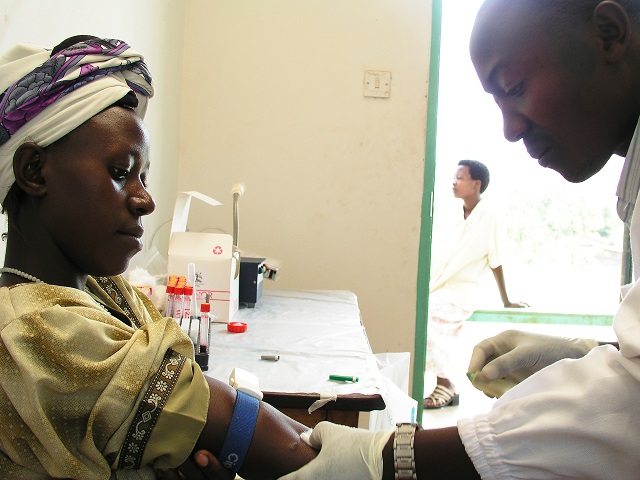
Study reveals critical gaps in access to vital diagnostic and treatment services, urges comprehensive reforms
Kampala, Uganda | RONALD MUSOKE | While diagnostics, vaccination, and treatment (DVT) services for prevalent ailments like COVID-19, hepatitis B, cervical cancer, HIV/AIDS, and syphilis are readily available in Uganda, a recent study conducted by two local civil society organizations shows access to these vital services is still impeded by shortages and stockouts.
The study carried out mid-2023 by the Coalition for Health Promotion and Social Development (HEPS-Uganda) and Afya Na Haki, sought to assess the availability of diagnostic, vaccination and treatment services in 34 sampled health facilities in 12 districts of Wakiso, Kiboga, Hoima, Masindi, Mbarara, Isingiro, Lira, Gulu, Kamuli, Pallisa, Arua and Nebbi. The study also sought to find out the barriers to accessing COVID-19, hepatitis B, HIV/TB, syphilis and cervical cancer diagnostic, vaccination and treatment services.
According to the study which was unveiled on Oct.25 in Kampala, the five diseases were selected due to their strategic significance to the Ministry of Health planning frameworks.
Overall, HIV/AIDS and syphilis prevention, diagnosis and treatment services were the most available, while treatment services for cervical cancer and hepatitis B were the least available. Most of the facilities under review (12 health centre IIIs, 12 health centre IVs and 10 hospitals) offered HIV/AIDS treatment and care services as well as syphilis prevention, diagnosis and treatment services.
Services that were most widely provided included; hepatitis B testing (91%, 32/34 facilities), HIV/AIDS testing 97%, 33/34), HIV/AIDS prevention services (97%, 33/34), syphilis treatment (97%, 33/34) and syphilis testing (100%, 34/34). All facilities that were assessed also had the Rapid Diagnostic Test (RDT) services for HIV; 82% (28/34) of them had self-test kits; while 53% (18/34) offered PCR testing services for HIV.
However, in regards to availability of syphilis diagnosis, prevention, testing and treatment services, shortage or stockouts of testing kits (34%, 11/32) was identified as a big challenge. There was also shortage and stockouts of the hepatitis B testing kits and commodities which was attributed to under prioritization (28%, 8/29) and inadequate funding for the procurement of commodities (17%, 5/29).
Interestingly, Hepatitis B is actually prevalent in many communities in northern and northwestern Uganda. “It is yet to get the much-needed focus you notice around HIV/AIDS or TB,” Anthony Ssebagereka, the Principal Investigator of the study told The Independent.
Ssebagereka told The Independent that one of the possible explanations for DVT services being widely available for HIV/AIDS, syphilis and to some extent cervical cancer has more to do with availability of donor funding.
“These are ‘programme diseases;’ a lot of money has been sunk into prevention services and there is a lot of monitoring work that goes on around these diseases,” he told The Independent, “The facilities are supposed to report about the uptake of services on a regular basis and there is also follow-up if there is stock-out of essential commodities.”
On the other hand, Ssebagereka explained, although people, especially in West Nile and northern Uganda are more vigilant and are willing to test and get vaccinated against hepatitis B, they rarely get the services.
“They are constantly turned away because they are told the only hepatitis B vaccines available are for babies. Some facilities which we found doing testing, the re-agents were not enough, possibly due to high demand.”
Ignorance and misinformation
Interestingly, Ssebagereka noted that in the west, central and eastern parts of the country, people were not as knowledgeable about hepatitis B services as their counterparts in the north and the Northwest of the country. In fact, across all the health conditions, lack of awareness and misinformation were identified as major barriers to access to diagnostic, vaccination and treatment services and products.
Some of the challenges cited by respondents included; lack of awareness of hepatitis B and the available DVT services at the different levels of care; a high prevalence of myths and misconceptions; reluctance of patients to return to health facilities for review; limited capacities for management of hepatitis B cases at lower health facilities; weak referral system due to gaps in diagnostic and competence capacities; and long turn-around time for test results.
The main challenge faced in the delivery of hepatitis B vaccination services was the shortage/stockouts of testing kits (28%, 8/28 of facilities) followed by long waiting times and under-staffing at health facilities.
Hepatitis B commodities stock-outs
In other facilities, they not only get stock-outs for hepatitis B vaccines but also gloves, safety boxes and syringes. In one of the facilities, it was noted that Adult Hepatitis B vaccines were out of stock since 2018 to date, there have been no supplies.
One facility that provides vaccination services reported to have not received supplies of hepatitis B vaccines for “almost a year,” thanks to delays in supply of commodities by National Medical Stores (NMS).
As a result, some facilities have taken advantage of the high demand for services and reportedly charge Shs180,000-220,000 for hepatitis B testing at Central Health Laboratories (CPHL) and private facilities.
In order to cope with the demand, some health facilities reported the main option during stockouts of hepatitis B, DVT commodities to include borrowing from other health facilities; redistribution from facilities with over supply; sourcing from the district stores; and referral to higher-level facilities.
However, for cases that are advanced or need confirmatory tests, liver function tests or viral load tests are in most cases referred to higher-level facilities due to limited capacity at lower-level facilities in terms of staff competencies, equipment and supplies. Some facilities that offer diagnostic services for hepatitis B, do not provide treatment services, and refer all positive cases to higher-level facilities.
For COVID-19 vaccination and treatment services, the main challenges within the facilities included declining demand for vaccination, large supplies of vaccines with short shelf life, reluctance of clients to accept vaccine mixing, limited space, shortage of medicines, low risk perception, and misinformation and lack of awareness.
Publicized services unavailable
Richard Hasunira, the co-investigator for the study told The Independent that civil society is concerned about the continued mismatch in publicized DVT services and actual availability because this often disappoints people who actually are yearning for the health services.
“What is of concern to civil society is the “many government health facilities which advertise particular services but when people go there, they don’t find the advertised services.”
“Either it will be because the person who vaccinates is not available or the vaccine brand an individual wants is not available. In other instances, the laboratory attendant is rarely on site,” he said. At other government facilities, patients are asked to go seek diagnostic services in other facilities and come back for prescription, he said.
Hasunira told The Independent that when a health facility does not have all the services on site, that often makes a service incomplete. According to the study, quality of services and health outcomes are strongly linked to access of diagnostic, treatment and vaccination services for the diseases reviewed in the study.
“COVID-19, hepatitis B, cervical cancer, HIV/AIDS, and syphilis services which have been noted to collectively be responsible for the highest morbidity and mortality among Uganda’s adult population.”
DVT sector is underfunded
Morries Seru, the Commissioner Pharmaceutical Services and Natural Medicines at the Ministry of Health stopped short of admitting the challenges facing the diagnostic, vaccination and testing service in Uganda. He told The Independent that “Uganda still has a long way to go.”
In regards to diagnostic services, he admitted the government has not funded the sub-sector adequately and yet these services are important in the treatment chain. “We don’t put much money into diagnostics and that is why, quite often, some doctors use their clinical acumen before they prescribe medicine for people,” he said.
Seru told The Independent that the government will also have to deliberately strengthen the regulatory arm of diagnostic services especially medical laboratories but also subsidize diagnostic services in the country if it is to decisively deal with quack laboratories which often dupe clients with fake or misleading test results. “Many of our people who have hepatitis B find out when it is too late; people also come for cancer treatment when it’s too late,” he told The Independent.
DVTs in hospitals similar to supplies in home
Ssebagereka, the Principal Investigator told The Independent that the study shows that the importance of DVTs in health facilities cannot be overemphasized. “It can only be compared to a home; just like a functional home should have essential utilities like water, electricity and food, so should a health facility have DVT services.”
“These are literally the engine of any country’s health system. Even when you might have a robust cadre of health care workers, without DVT services, a health facility cannot function like it should be. What is very clear is that we have both demand and supply issues and we need to re-focus and put more resources where they are more needed,” he said.
Joan Kilande, the health policy advocacy programme manager at HEPS-Uganda told The Independent the assessment which is part of a broader programme – the Africentric Advocacy and Research Approaches to Advancing Regional Vaccine Manufacturing and Access in Africa (ARM Programme) – aims at raising awareness among policy makers, service providers and health care consumers on the importance of proper diagnosis as well as the existing gaps and challenges in the provision of diagnostic and monitoring services.
She said addressing the current challenges in diagnostic and disease monitoring services will go a long way in minimizing the guesswork that often comes with reliance on clinical signs; anti-microbial resistance that follows underuse, overuse and abuse of medicines that comes with self-medication and wrong and inappropriate medicine prescription.
She said making testing services at public health facilities available, functional and accessible will not only improve health outcomes, but will also enable the country make progress on national and global health outcomes and commitments.
Possible remedies to DVT services
Going forward, the study recommends National Medical Stores, the agency that procures, stores and distributes essential medicines and medical supplies to public health facilities in Uganda, to adhere to the prescribed order schedule for delivery.
“There is also need to limit delivery of vaccines and supplies with short shelf life,” the study notes, adding that the health ministry and implementing partners need to strengthen targeted trainings for health workers especially on Hepatitis B, cervical cancer and syphilis.
The study further recommends the health ministry and development partners to support local governments, non-state actors and community groups to do regular public health awareness programmes on access to DVTs and disease prevention around Uganda.
 The Independent Uganda: You get the Truth we Pay the Price
The Independent Uganda: You get the Truth we Pay the Price






xchjmjl